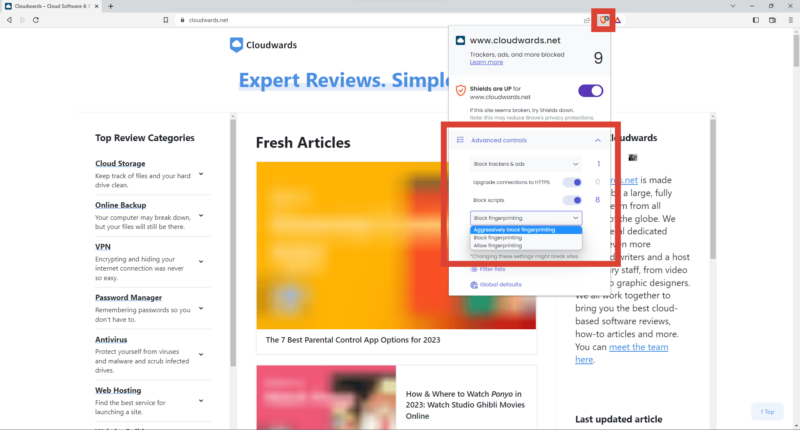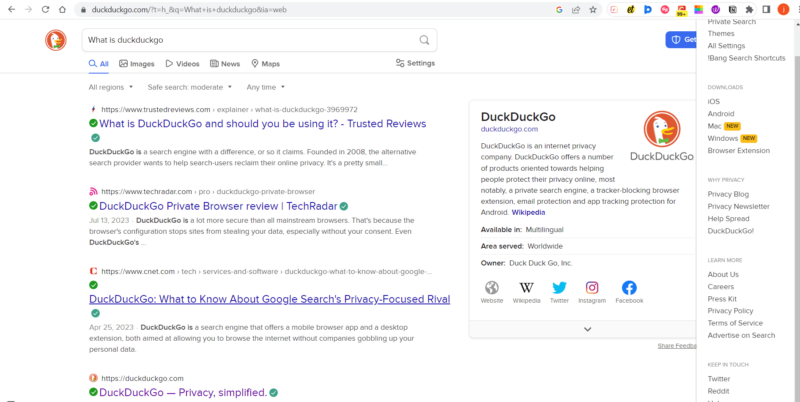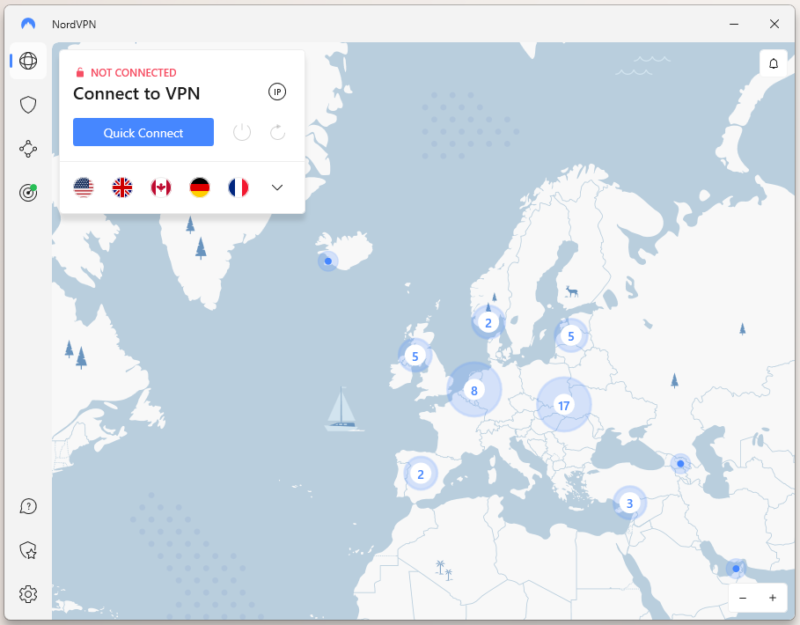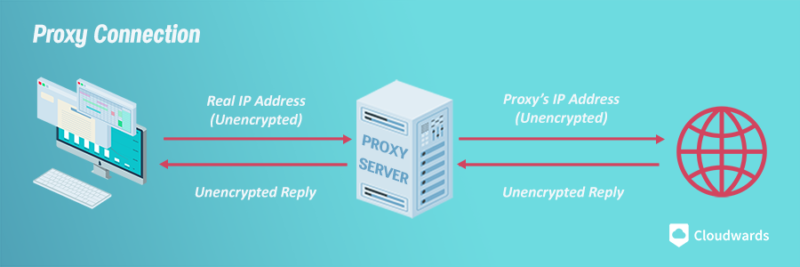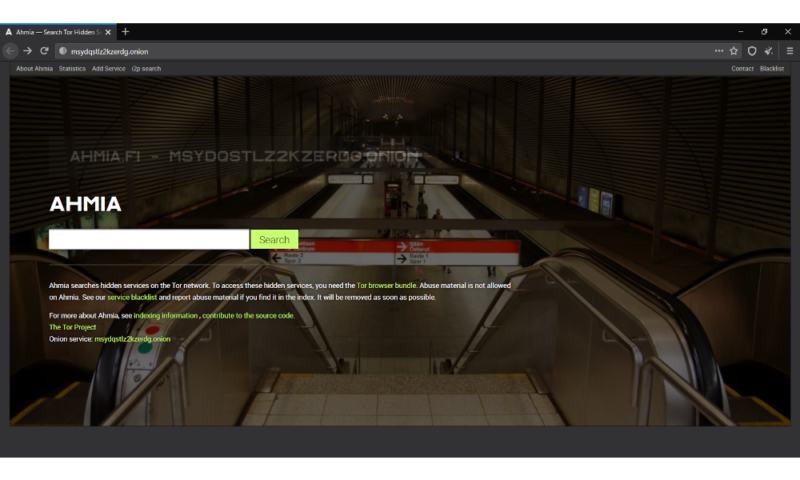Anonymous Browsing Guide in 2024: Avoid Online Tracking
Cloudwards.net may earn a small commission from some purchases made through our site. However, any earnings do not affect how we review services. Learn more about our editorial integrity and research process.
Your browsing history can reveal all kinds of sensitive personal data that can be tracked, analyzed and exploited. With big tech conglomerates, ISPs, governments, advertisers and hackers all vying for that information, anonymous browsing has become an increasingly valuable skill.
This guide will teach you what anonymous browsing is and explain how it differs from just using Incognito mode. In addition, you’ll learn how websites track you as you browse the web. We’ll cover practical methods and tools to help you navigate the web more discreetly, so follow along to learn how to stay anonymous online.
-
10/03/2021
Update the article to include how-to guides, FAQ, key takeaways and new images.
-
10/10/2024 Facts checked
Rewritten to include more modern anonymous browsing methods and explain the methods that websites use to track your activity.
What Is Anonymous Browsing?
Anonymous browsing refers to minimizing your digital footprint on the internet by masking your identity, location, device information and browsing habits. The goal of anonymous browsing is to prevent third parties from tracking you across the different websites you visit, and to reduce the amount of personally identifying data you leave behind.
This way of browsing the web makes it difficult for anyone to track your online activity, identify you, and profile you for targeted advertising or social engineering. While true anonymity is difficult — if not impossible — to achieve, anonymous browsing best practices can still reduce the risk of exposing your personal data to the internet.
- Comprehend the essential role a VPN plays in safeguarding your digital life
- Gain a deep understanding of how VPNs function under the hood
- Develop the ability to distinguish fact from fiction in VPN promotions
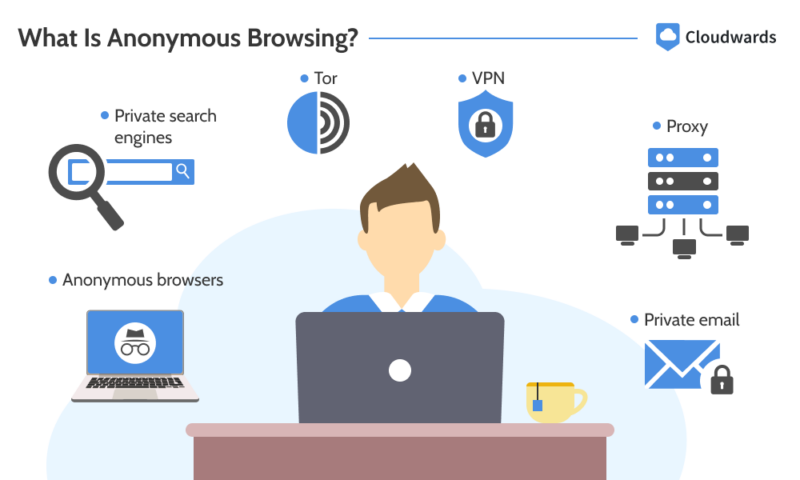
Anonymous browsing relies on a combination of techniques and tools, as well as good general privacy practices to keep you anonymous online.
Reasons to Browse Anonymously
You may think you don’t need to browse anonymously because you have nothing to hide if you’re not a criminal. However, that’s not quite the case. There are many practical reasons to reduce the amount of data you leave across the web. Here are a few reasons why you should consider anonymous browsing:
- Protect online privacy: Anonymous browsing can prevent companies from creating detailed profiles of your online behaviors and personal interests.
- Ensure online security: Anonymous browsing can protect you from personalized cyberattacks that use social engineering methods.
- Bypass censorship: If your government censors certain content, anonymous browsing can help bypass the blocks by masking your IP address and changing your perceived location.
- Avoid price discrimination: Price discrimination is a practice where a company adjusts its prices based on data like your age, location or spending habits. Anonymous browsing can prevent this.
- Avoid targeted ads: Using anonymous browsing stops advertisers from creating ad profiles on you and serving you targeted ads.
- Access restricted content: If you use an anonymous browsing tool like a VPN or proxy, you can change your virtual location to access local content in another area.
Anonymous Browsing vs Private Browsing
Private browsing simply involves using your browser’s built-in private mode, such as Google Chrome’s Incognito mode. This browsing method prevents the browser from creating on-device data, which means no browser history is kept on your device.
However, it does nothing to stop websites and other third parties from tracking your activity. As a recent court case showed, it certainly doesn’t prevent Google itself from harvesting your Incognito mode browsing data.
In contrast, anonymous browsing aims to block tech companies, ISPs, government agencies and cybercriminals from harvesting your data. Various anonymous browsing techniques can encrypt your data, hide or alter your IP address, and change your overall online identity. These methods attempt to decouple your browsing activity from your person.
How Web Tracking Works
Web tracking utilizes various techniques and technologies to monitor and collect data about your online activity. Those looking to track user activity may use at least one of the following methods, though they generally employ a combination of them.
Thankfully, you can use plenty of tools to keep yourself anonymous online. Just remember that no single tool can protect you completely. We often tout VPNs as the best standalone privacy tool, but even they aren’t foolproof. For example, they don’t protect against things like device fingerprinting. We suggest using a few of the following online security tools in combination.
Although most operating systems and social media platforms track your activity in some form — regardless of your settings and preferences — you can take steps to minimize tracking. Here are a few guides on how to stay as anonymous as possible on social media platforms and smartphones.
Final Thoughts
While complete online anonymity remains next to impossible, the techniques and tools covered in this guide should substantially improve your online privacy. To ensure effective anonymous browsing, you should use a combination of approaches. It’s also important to be mindful of your online behavior, and to regularly update your knowledge of tracking methods and privacy tools.
What are your personal reasons to stay anonymous online? Do you use any tools to maintain anonymity? Which privacy tools do you use? Please let us know in the comments below, and as always, thank you for reading.
FAQ: Anonymous Web Browsing
Anonymous browsing refers to using the internet in a way that minimizes what data you reveal to the websites you visit, your ISP or any other entities that might be tracking your online activity.
No method of browsing is truly anonymous. However, you can get pretty close to true anonymity by implementing anonymous browsing techniques to reduce your digital footprint to a bare minimum.
There is no truly anonymous browser, but Brave and Firefox come close. Still, the level of anonymity that your browser provides will depend on your chosen privacy settings and your mindfulness regarding your browsing habits.
You can go anonymous browsing by utilizing anonymous browsing methods, such as using a VPN, private browser, non-tracking search engine and private email service.
Cloudwards.net may earn a small commission from some purchases made through our site. However, any earnings do not affect how we review services. Learn more about our editorial integrity and research process.
Your browsing history can reveal all kinds of sensitive personal data that can be tracked, analyzed and exploited. With big tech conglomerates, ISPs, governments, advertisers and hackers all vying for that information, anonymous browsing has become an increasingly valuable skill.
This guide will teach you what anonymous browsing is and explain how it differs from just using Incognito mode. In addition, you’ll learn how websites track you as you browse the web. We’ll cover practical methods and tools to help you navigate the web more discreetly, so follow along to learn how to stay anonymous online.
-
10/03/2021
Update the article to include how-to guides, FAQ, key takeaways and new images.
-
10/10/2024 Facts checked
Rewritten to include more modern anonymous browsing methods and explain the methods that websites use to track your activity.
What Is Anonymous Browsing?
Anonymous browsing refers to minimizing your digital footprint on the internet by masking your identity, location, device information and browsing habits. The goal of anonymous browsing is to prevent third parties from tracking you across the different websites you visit, and to reduce the amount of personally identifying data you leave behind.
This way of browsing the web makes it difficult for anyone to track your online activity, identify you, and profile you for targeted advertising or social engineering. While true anonymity is difficult — if not impossible — to achieve, anonymous browsing best practices can still reduce the risk of exposing your personal data to the internet.
- Comprehend the essential role a VPN plays in safeguarding your digital life
- Gain a deep understanding of how VPNs function under the hood
- Develop the ability to distinguish fact from fiction in VPN promotions

Anonymous browsing relies on a combination of techniques and tools, as well as good general privacy practices to keep you anonymous online.
Reasons to Browse Anonymously
You may think you don’t need to browse anonymously because you have nothing to hide if you’re not a criminal. However, that’s not quite the case. There are many practical reasons to reduce the amount of data you leave across the web. Here are a few reasons why you should consider anonymous browsing:
- Protect online privacy: Anonymous browsing can prevent companies from creating detailed profiles of your online behaviors and personal interests.
- Ensure online security: Anonymous browsing can protect you from personalized cyberattacks that use social engineering methods.
- Bypass censorship: If your government censors certain content, anonymous browsing can help bypass the blocks by masking your IP address and changing your perceived location.
- Avoid price discrimination: Price discrimination is a practice where a company adjusts its prices based on data like your age, location or spending habits. Anonymous browsing can prevent this.
- Avoid targeted ads: Using anonymous browsing stops advertisers from creating ad profiles on you and serving you targeted ads.
- Access restricted content: If you use an anonymous browsing tool like a VPN or proxy, you can change your virtual location to access local content in another area.
Anonymous Browsing vs Private Browsing
Private browsing simply involves using your browser’s built-in private mode, such as Google Chrome’s Incognito mode. This browsing method prevents the browser from creating on-device data, which means no browser history is kept on your device.
However, it does nothing to stop websites and other third parties from tracking your activity. As a recent court case showed, it certainly doesn’t prevent Google itself from harvesting your Incognito mode browsing data.
In contrast, anonymous browsing aims to block tech companies, ISPs, government agencies and cybercriminals from harvesting your data. Various anonymous browsing techniques can encrypt your data, hide or alter your IP address, and change your overall online identity. These methods attempt to decouple your browsing activity from your person.
How Web Tracking Works
Web tracking utilizes various techniques and technologies to monitor and collect data about your online activity. Those looking to track user activity may use at least one of the following methods, though they generally employ a combination of them.
Thankfully, you can use plenty of tools to keep yourself anonymous online. Just remember that no single tool can protect you completely. We often tout VPNs as the best standalone privacy tool, but even they aren’t foolproof. For example, they don’t protect against things like device fingerprinting. We suggest using a few of the following online security tools in combination.
Although most operating systems and social media platforms track your activity in some form — regardless of your settings and preferences — you can take steps to minimize tracking. Here are a few guides on how to stay as anonymous as possible on social media platforms and smartphones.
Final Thoughts
While complete online anonymity remains next to impossible, the techniques and tools covered in this guide should substantially improve your online privacy. To ensure effective anonymous browsing, you should use a combination of approaches. It’s also important to be mindful of your online behavior, and to regularly update your knowledge of tracking methods and privacy tools.
What are your personal reasons to stay anonymous online? Do you use any tools to maintain anonymity? Which privacy tools do you use? Please let us know in the comments below, and as always, thank you for reading.
FAQ: Anonymous Web Browsing
Anonymous browsing refers to using the internet in a way that minimizes what data you reveal to the websites you visit, your ISP or any other entities that might be tracking your online activity.
No method of browsing is truly anonymous. However, you can get pretty close to true anonymity by implementing anonymous browsing techniques to reduce your digital footprint to a bare minimum.
There is no truly anonymous browser, but Brave and Firefox come close. Still, the level of anonymity that your browser provides will depend on your chosen privacy settings and your mindfulness regarding your browsing habits.
You can go anonymous browsing by utilizing anonymous browsing methods, such as using a VPN, private browser, non-tracking search engine and private email service.
Cloudwards.net may earn a small commission from some purchases made through our site. However, any earnings do not affect how we review services. Learn more about our editorial integrity and research process.
Your browsing history can reveal all kinds of sensitive personal data that can be tracked, analyzed and exploited. With big tech conglomerates, ISPs, governments, advertisers and hackers all vying for that information, anonymous browsing has become an increasingly valuable skill.
This guide will teach you what anonymous browsing is and explain how it differs from just using Incognito mode. In addition, you’ll learn how websites track you as you browse the web. We’ll cover practical methods and tools to help you navigate the web more discreetly, so follow along to learn how to stay anonymous online.
-
10/03/2021
Update the article to include how-to guides, FAQ, key takeaways and new images.
-
10/10/2024 Facts checked
Rewritten to include more modern anonymous browsing methods and explain the methods that websites use to track your activity.
What Is Anonymous Browsing?
Anonymous browsing refers to minimizing your digital footprint on the internet by masking your identity, location, device information and browsing habits. The goal of anonymous browsing is to prevent third parties from tracking you across the different websites you visit, and to reduce the amount of personally identifying data you leave behind.
This way of browsing the web makes it difficult for anyone to track your online activity, identify you, and profile you for targeted advertising or social engineering. While true anonymity is difficult — if not impossible — to achieve, anonymous browsing best practices can still reduce the risk of exposing your personal data to the internet.
- Comprehend the essential role a VPN plays in safeguarding your digital life
- Gain a deep understanding of how VPNs function under the hood
- Develop the ability to distinguish fact from fiction in VPN promotions

Anonymous browsing relies on a combination of techniques and tools, as well as good general privacy practices to keep you anonymous online.
Reasons to Browse Anonymously
You may think you don’t need to browse anonymously because you have nothing to hide if you’re not a criminal. However, that’s not quite the case. There are many practical reasons to reduce the amount of data you leave across the web. Here are a few reasons why you should consider anonymous browsing:
- Protect online privacy: Anonymous browsing can prevent companies from creating detailed profiles of your online behaviors and personal interests.
- Ensure online security: Anonymous browsing can protect you from personalized cyberattacks that use social engineering methods.
- Bypass censorship: If your government censors certain content, anonymous browsing can help bypass the blocks by masking your IP address and changing your perceived location.
- Avoid price discrimination: Price discrimination is a practice where a company adjusts its prices based on data like your age, location or spending habits. Anonymous browsing can prevent this.
- Avoid targeted ads: Using anonymous browsing stops advertisers from creating ad profiles on you and serving you targeted ads.
- Access restricted content: If you use an anonymous browsing tool like a VPN or proxy, you can change your virtual location to access local content in another area.
Anonymous Browsing vs Private Browsing
Private browsing simply involves using your browser’s built-in private mode, such as Google Chrome’s Incognito mode. This browsing method prevents the browser from creating on-device data, which means no browser history is kept on your device.
However, it does nothing to stop websites and other third parties from tracking your activity. As a recent court case showed, it certainly doesn’t prevent Google itself from harvesting your Incognito mode browsing data.
In contrast, anonymous browsing aims to block tech companies, ISPs, government agencies and cybercriminals from harvesting your data. Various anonymous browsing techniques can encrypt your data, hide or alter your IP address, and change your overall online identity. These methods attempt to decouple your browsing activity from your person.
How Web Tracking Works
Web tracking utilizes various techniques and technologies to monitor and collect data about your online activity. Those looking to track user activity may use at least one of the following methods, though they generally employ a combination of them.
Thankfully, you can use plenty of tools to keep yourself anonymous online. Just remember that no single tool can protect you completely. We often tout VPNs as the best standalone privacy tool, but even they aren’t foolproof. For example, they don’t protect against things like device fingerprinting. We suggest using a few of the following online security tools in combination.
Although most operating systems and social media platforms track your activity in some form — regardless of your settings and preferences — you can take steps to minimize tracking. Here are a few guides on how to stay as anonymous as possible on social media platforms and smartphones.
Final Thoughts
While complete online anonymity remains next to impossible, the techniques and tools covered in this guide should substantially improve your online privacy. To ensure effective anonymous browsing, you should use a combination of approaches. It’s also important to be mindful of your online behavior, and to regularly update your knowledge of tracking methods and privacy tools.
What are your personal reasons to stay anonymous online? Do you use any tools to maintain anonymity? Which privacy tools do you use? Please let us know in the comments below, and as always, thank you for reading.
FAQ: Anonymous Web Browsing
Anonymous browsing refers to using the internet in a way that minimizes what data you reveal to the websites you visit, your ISP or any other entities that might be tracking your online activity.
No method of browsing is truly anonymous. However, you can get pretty close to true anonymity by implementing anonymous browsing techniques to reduce your digital footprint to a bare minimum.
There is no truly anonymous browser, but Brave and Firefox come close. Still, the level of anonymity that your browser provides will depend on your chosen privacy settings and your mindfulness regarding your browsing habits.
You can go anonymous browsing by utilizing anonymous browsing methods, such as using a VPN, private browser, non-tracking search engine and private email service.
Cloudwards.net may earn a small commission from some purchases made through our site. However, any earnings do not affect how we review services. Learn more about our editorial integrity and research process.
Your browsing history can reveal all kinds of sensitive personal data that can be tracked, analyzed and exploited. With big tech conglomerates, ISPs, governments, advertisers and hackers all vying for that information, anonymous browsing has become an increasingly valuable skill.
This guide will teach you what anonymous browsing is and explain how it differs from just using Incognito mode. In addition, you’ll learn how websites track you as you browse the web. We’ll cover practical methods and tools to help you navigate the web more discreetly, so follow along to learn how to stay anonymous online.
-
10/03/2021
Update the article to include how-to guides, FAQ, key takeaways and new images.
-
10/10/2024 Facts checked
Rewritten to include more modern anonymous browsing methods and explain the methods that websites use to track your activity.
What Is Anonymous Browsing?
Anonymous browsing refers to minimizing your digital footprint on the internet by masking your identity, location, device information and browsing habits. The goal of anonymous browsing is to prevent third parties from tracking you across the different websites you visit, and to reduce the amount of personally identifying data you leave behind.
This way of browsing the web makes it difficult for anyone to track your online activity, identify you, and profile you for targeted advertising or social engineering. While true anonymity is difficult — if not impossible — to achieve, anonymous browsing best practices can still reduce the risk of exposing your personal data to the internet.
- Comprehend the essential role a VPN plays in safeguarding your digital life
- Gain a deep understanding of how VPNs function under the hood
- Develop the ability to distinguish fact from fiction in VPN promotions

Anonymous browsing relies on a combination of techniques and tools, as well as good general privacy practices to keep you anonymous online.
Reasons to Browse Anonymously
You may think you don’t need to browse anonymously because you have nothing to hide if you’re not a criminal. However, that’s not quite the case. There are many practical reasons to reduce the amount of data you leave across the web. Here are a few reasons why you should consider anonymous browsing:
- Protect online privacy: Anonymous browsing can prevent companies from creating detailed profiles of your online behaviors and personal interests.
- Ensure online security: Anonymous browsing can protect you from personalized cyberattacks that use social engineering methods.
- Bypass censorship: If your government censors certain content, anonymous browsing can help bypass the blocks by masking your IP address and changing your perceived location.
- Avoid price discrimination: Price discrimination is a practice where a company adjusts its prices based on data like your age, location or spending habits. Anonymous browsing can prevent this.
- Avoid targeted ads: Using anonymous browsing stops advertisers from creating ad profiles on you and serving you targeted ads.
- Access restricted content: If you use an anonymous browsing tool like a VPN or proxy, you can change your virtual location to access local content in another area.
Anonymous Browsing vs Private Browsing
Private browsing simply involves using your browser’s built-in private mode, such as Google Chrome’s Incognito mode. This browsing method prevents the browser from creating on-device data, which means no browser history is kept on your device.
However, it does nothing to stop websites and other third parties from tracking your activity. As a recent court case showed, it certainly doesn’t prevent Google itself from harvesting your Incognito mode browsing data.
In contrast, anonymous browsing aims to block tech companies, ISPs, government agencies and cybercriminals from harvesting your data. Various anonymous browsing techniques can encrypt your data, hide or alter your IP address, and change your overall online identity. These methods attempt to decouple your browsing activity from your person.
How Web Tracking Works
Web tracking utilizes various techniques and technologies to monitor and collect data about your online activity. Those looking to track user activity may use at least one of the following methods, though they generally employ a combination of them.
Thankfully, you can use plenty of tools to keep yourself anonymous online. Just remember that no single tool can protect you completely. We often tout VPNs as the best standalone privacy tool, but even they aren’t foolproof. For example, they don’t protect against things like device fingerprinting. We suggest using a few of the following online security tools in combination.
Although most operating systems and social media platforms track your activity in some form — regardless of your settings and preferences — you can take steps to minimize tracking. Here are a few guides on how to stay as anonymous as possible on social media platforms and smartphones.
Final Thoughts
While complete online anonymity remains next to impossible, the techniques and tools covered in this guide should substantially improve your online privacy. To ensure effective anonymous browsing, you should use a combination of approaches. It’s also important to be mindful of your online behavior, and to regularly update your knowledge of tracking methods and privacy tools.
What are your personal reasons to stay anonymous online? Do you use any tools to maintain anonymity? Which privacy tools do you use? Please let us know in the comments below, and as always, thank you for reading.
FAQ: Anonymous Web Browsing
Anonymous browsing refers to using the internet in a way that minimizes what data you reveal to the websites you visit, your ISP or any other entities that might be tracking your online activity.
No method of browsing is truly anonymous. However, you can get pretty close to true anonymity by implementing anonymous browsing techniques to reduce your digital footprint to a bare minimum.
There is no truly anonymous browser, but Brave and Firefox come close. Still, the level of anonymity that your browser provides will depend on your chosen privacy settings and your mindfulness regarding your browsing habits.
You can go anonymous browsing by utilizing anonymous browsing methods, such as using a VPN, private browser, non-tracking search engine and private email service.
